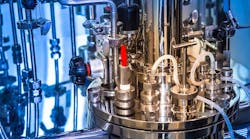Greg: Last June, we learned from our dialog with automation engineer David Bruton how critical pH measurement and control was to bioreactor performance (see “Keys to bioreactor pH performance", Control, June 2022, p. 40). Also, we learned the importance of acceptance and commitment of plant staff, which is gained through personal relationships with plant staff. Since we last spoke, Bruton has been busy starting his own company called “Tune The Process LLC” (https://www.TuneTheProcess.com). Here, he offers us his experience and expertise in temperature measurement and control.
Tight bioreactor temperature control is critical for cell health and productivity for modern biologics. What jacket temperature control system features help achieve tight temperature control?
David: Most of the bioreactors have a jacket fed by a heat exchanger that is controlled through a split range to allow for heating and cooling with one control loop. With this split range, it’s important the physical side is designed correctly. Otherwise, there’s only so much improvement that tuning the controls can do. To keep the dynamics consistent and reliable, it’s best to maintain the constant flow through the jacket and control the temperature through a makeup flow. The designer should choose a valve and system that minimizes abrupt changes to the flow, temperature or switching heat transfer mediums—especially at the split range point.
Greg: Is there a limit as to how cold or warm jacket temperature can be for cell health and productivity?
David: Cell cultures are quite particular when it comes to their optimal temperatures. Mammalian cell cultures prefer to be around 36 °C to 37 °C while insect cells grow more optimally at 27 °C. Overshooting the jacket temperature can be of special concern to prevent damage to cells or single-use bags at the edges of the reactor.
Greg: How do you minimize bioreactor temperature setpoint overshoot?
David: Often temperature control is required to meet a setpoint within tenths of a degree. So, temperature overshoot is a great concern. Because batch cycle times are so long, waiting for a slow setpoint change can be a worthwhile tradeoff. Using a setpoint filter to slow down setpoint changes can eliminate overshoot when set to the reset time (as seen in Figure 1).
Other advanced features can be implemented to save on time as well. For example, lead-lag applied to the setpoint allows for a larger initial bump to the setpoint change while maintaining the slow approach to setpoint. Another option is to use a full throttle startup, which entails setting the jacket controller to maximum allowable temperature until the reactor temperature is close to the desired setpoint. Then, reduce the jacket temperature and switch the control to reactor control.
Greg: Are there different temperature setpoints early in batch cycle to maximize cell growth and later in batch cycle to maximize product formation rate? How do you determine the best time for the setpoint change?
David: There are often several temperature setpoints throughout the production run. All products and cell linings have different requirements to allow them to express or produce the desired product best. This is often tested by performing many runs at a lab scale before scaling up to production. Online analysis of cell growth during production runs could be used to verify and further improve the timing of these setpoint changes.
Greg: What are some best practices for temperature sensor installation to ensure temperature measurement is representative of batch temperature with an excellent signal-to-noise ratio?
David: It is important to have the thermowell tip extend far enough into the bioreactor so that it is not influenced by the cooler vessel wall. It’s preferable to have it near or above the agitator so it can see some significant fluid movement. The tip must be strategically located away from the gas spargers for dissolved oxygen control and pH control so as not have an impact by the bubbles. The insertion distance also needs to be long enough to minimize the heat conduction loss along the thermowell wall.
Greg: What type of temperature sensor is used to maximize measurement accuracy and speed?
David: A spring-loaded, tight-fitting resistance temperature detector (RTD) in a stepped thermowell provides the fastest and most accurate response. The repeatability and drift of RTDs are two orders of magnitude better than thermocouples. The sensitivity, linearity and signal strength of RTDs are also outstanding.
Greg: There are many key aspects of jacket temperature control not commonly understood. The most common mistake is not keeping the jacket flow constant. This keeps the heat transfer coefficient more constant and higher since it is generally proportional to flow to 0.8 power. It also decreases fouling and jacket temperature sensor lag that dramatically increases below 1 fps. It also reduces the process dead time from transportation delay and makes the process gain more linear since it is inversely proportional to flow.
How have you seen differing measurement locations impact control?
David: Jacket temperatures measured at the inlet to the jacket can preemptively correct for utility disturbances and have a faster response. Jacket temperatures measured at the outlet of the jacket can better correct for disturbances originating in the vessel due to process disturbances in batch temperature. However, process disturbances are generally extremely slow in bioreactors. Changes in cell growth rate are exceptionally gradual especially for modern biologics where batch cycle times are often 10 days or more.
Greg: The transportation delay of the piping between the jacket outlet and the jacket inlet is generally quite small if the jacket flow is kept constant. This small transportation delay is often smaller than the delay through the jacket. The additional delay in seeing a gradual process disturbance at the jacket inlet ends up having a negligible effect. The faster response of jacket inlet temperature control can translate to faster tuning and a better setpoint response.
How do you handle the challenges of a reactor with both heating and cooling?
David: If the jacket provides heating and cooling, I usually see a heat exchanger to heat and chill the water line to the jacket. It’s important the split range does not send steam and chilled water directly to the jacket. The temperature extremes are too great and there are instabilities in the transition from steam to coolant due to residual bubbles. The same happens in the reverse direction from coolant to steam due to residual droplets. The traditional way to avoid this problem by using a heat exchanger in the jacket recirculation line. That helps the transition at the split range between heating and cooling the jacket water.
Greg: We found the heat transfer lag introduced by heat exchangers causes slower and looser jacket temperature control. The option of manipulating a bypass flow around the heat exchanger with the coolant flow fixed provides a faster, but more complex jacket temperature response. The initial response to an increase in bypass flow around a heat exchanger will cause a fast increase in water temperature returning to jacket. However, the slower flow through the heat exchanger results in a secondary response of decrease in the temperature returning to jacket. The net response is likely still an increase in water temperature returning to jacket because the heat transfer coefficient is less for the slower jacket water flow through the heat exchanger.
David: I’d imagine a valve position controller on the coolant flow could help with that secondary response and improve energy efficiency.
Greg: An even better solution for heating and cooling is a steam injector in the recirculating jacket water. The water temperature can be smoothly and quickly changed from cool to warm by injecting steam without changing the phase in the jacket water. If cooler water temperatures are needed, there can be a chilled water makeup flow manipulated by the jacket inlet temperature controller.
For more on biochemical reactor measurement and control and how the digital twin can play a key role, see my ISA book “New Directions in Bioprocess Modeling and Control – Second Edition.”
David: And if you’d like a second set of eyes on your control problems, whether tuning or batch related, I’m always looking for new challenges.






